1986 Hungarian Grand Prix race report
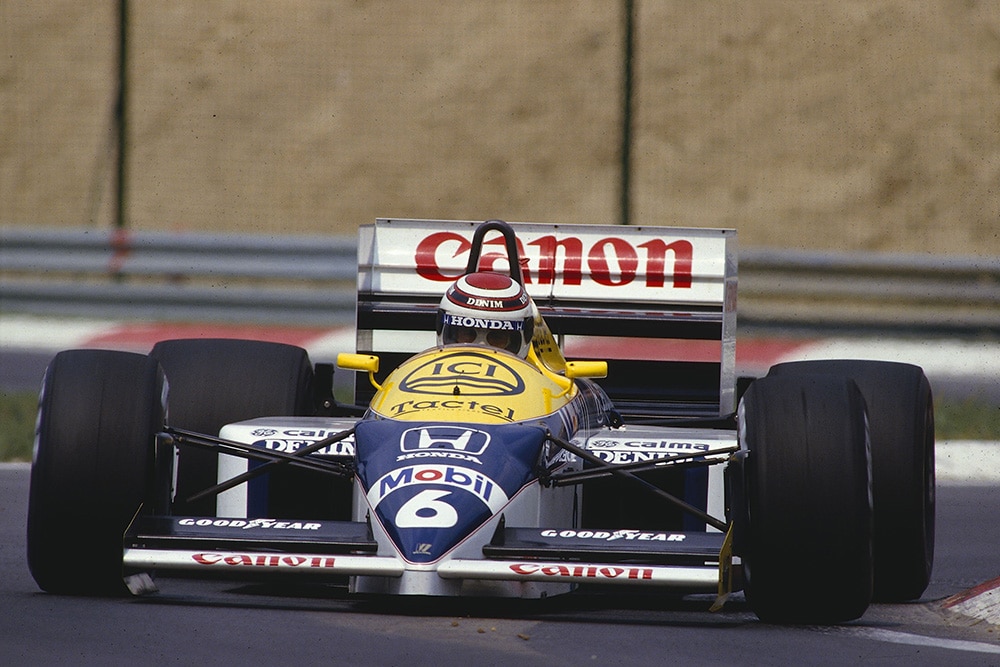
Williams' Nelson Piquet secured his third win of the season
Motorsport Images
By the banks of the Danube
When mention was first made about a possible Hungarian Grand Prix being entered on the 1986 FISA World Championship calendar, most people raised their eyebrows briefly and took little notice. It had been fifty years since Grand Prix cars last raced through a Budapest park and street circuit and although rounds of the European Touring Car Championship were held through the cobbled streets of the city during the 1960s, the thought of full-blooded turbocharged Grand Prix cars appearing again appeared a little fanciful.
However, through the enthusiasm of the Hungarian Automobile Federation and the commercial initiative of the Formula One Constructors Association, a deal was struck to bring this most capitalist of professional sports to the Eastern Bloc. Budapest was a wealthy watering home for the rich and socially prominent when Tazio Nuvolari put the city on the motor racing map with his splendid Alfa Romeo victory in 1936 and on a wider “gossip column” front, one of the European capitals which attracted the Prince of Wales and Wallis Simpson on their pre Abdication Crisis holiday travels round Europe.
A street race was obviously out of the question. A track laid out in the centre of Budapest would have eclipsed even Monaco for sheer architectural splendour and elegance. But, realistically, there was no way of organising such a spectacle. Instead, it was decided to construct a purpose-built circuit some 12 miles or so from the centre of the city, the 4.014km, 2.494 mile Hungaroring straddling a small valley just off one of the major motorways.
The result is a modern, well laid-out and splendidly organised facility rather reminiscent of the new Spanish Jerez track. But, although the drivers complained that the Hungaroring was lacking some fast corners and a really long straight, the organisation was sharper and more efficient than at Jerez. I can never recall a brand new circuit staging its inaugural Championship Grand Prix with as little fuss and as few teething troubles as the Hungaroring did. All the practice sessions began on time with military precision, the officials were courteous and, in the main, overwhelmingly considerate. Also a lot of people went to the Eastern Bloc imagining that the circuit might well be policed by armed soldiers all over the place. But there were far fewer than, say, at Monza and the crowd was well behaved and disciplined.
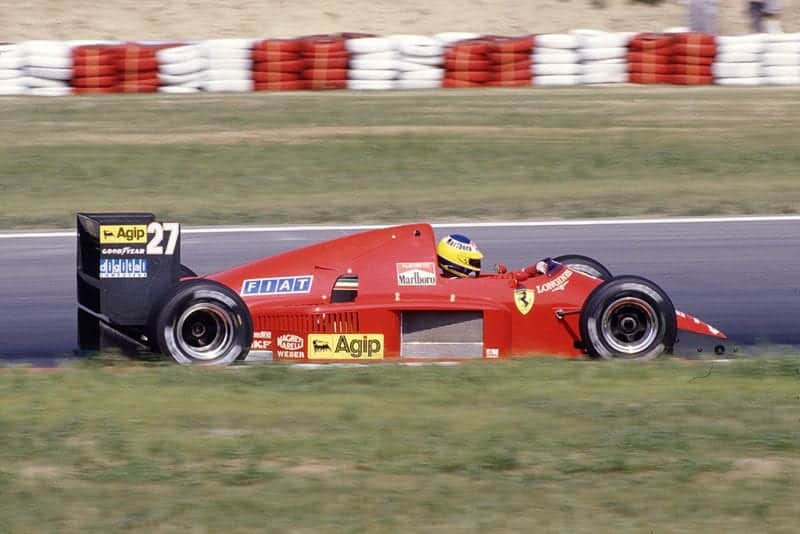
Michele Alboreto could only qualify his Ferrari 15th
Motorsport Images
To give the drivers a chance to learn this new circuit, an unofficial session took place on the Thursday prior to the usual three day schedule of official qualifying and the Grand Prix itself.
Being brand new and dusty, the track was very slippery indeed from the outset and, as the weekend progressed and rubber deposits gradually built up, so a distinct racing line appeared all round the circuit. The trouble was that if drivers deviated from this line for any reason, there was such a dramatic loss of grip that they almost immediately hit trouble.
It was for this reason that the fastest times were set on race rubber during Friday qualifying. Not only was the track slippery, but with few passing places there was even more of a premium on getting a clear lap. It was better to opt for hard tyres which would allow a driver to stay out lapping for longer. Two lap super-soft qualifying tyres represented too much of a gamble in these circumstances.
Qualifying
Nigel Mansell, who had celebrated his 32nd birthday by confirming that he will be staying on in the Williams camp for 1987 and ’88, emerged quickest on Friday using race rubber and the following afternoon hedged his bets by choosing one set of qualifying tyres and one set of race tyres. Mansell, who went off and damaged his Williams during Saturday’s untimed session avoiding Riccardo Patrese’s Brabham which wandered into his path, dropped to fourth place on the grid after finding Warwick’s Brabham and Streiff’s Tyrrell running side-by-side in front of him in the second session.
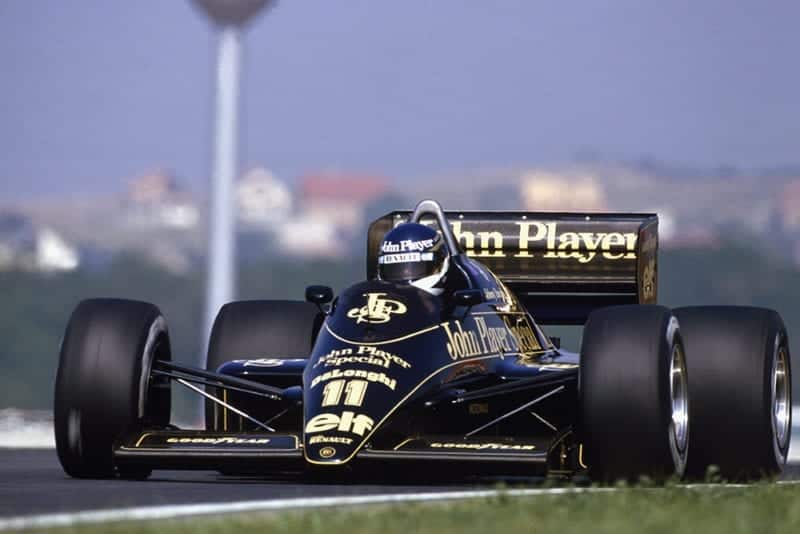
Johnny Dumfries set the 8th fastest qualifying time
Motorsport Images
It was left to Lotus team leader Ayrton Senna to take the most audacious qualifying gamble of the lot — and to come out the winner! Having spun several times on Friday in his enthusiasm to get the better of the slippery surface, Senna opted for two sets of soft qualifying rubber on Saturday. That meant he only had two chances and two laps to get pole position. He achieved just that on his first run, spinning on his second and then again on his third, when running on a mixed set of tyres made up from the best survivors of the first two runs.
Nelson Piquet made it an all Brazilian front row with his Williams-Honda, while World Champion Alain Prost qualified his McLaren MP4/2C on the inside of row two. The Frenchman had been struggling to rid his machine of understeer throughout qualifying and was a little frustrated not to have earned a front row berth. During the Saturday morning untimed session it was found that the front tyres’ grip was improved by subtly reducing their pressure, but, owing to an organisational misunderstanding the tyres were not pressured correctly for the final session. Nevertheless, the Frenchman was the only other competitor, after the two Brazilians, to break the 1 min 30 sec barrier during qualifying.
Behind Mansell came Keke Rosberg in the second McLaren, the Finn also grappling with excessive understeer, while Patrick Tambay utilised the new Ford V6 ‘s slow speed flexibility to good effect on this tight track to qualify sixth, the Team Haas squad’s best grid position so far. Tambay managed this despite suffering from brake pad “knock-off” as well as a ferociously aggressive on track confrontation with Ligier’s René Arnoux. Both men accused the other of inconsiderate baulking, each adjudging his rival a “complete lunatic”, in the pit lane afterwards. Competitive business, this F1 racing!
Poor engine response out of the slow corners hampered the Ferrari F186s, further aggravating their incipient understeer characteristics, but Stefan Johansson had his mechanics screw on as much front wing as they dared for the final session in an effort to promote some oversteer, hurling his mount round to qualify a fine seventh ahead of Johnny Dumfries, the Scot having now thoroughly got the hang of Formula 1 and driving with great confidence and control.
Michele Alboreto’s Ferrari was way back in 15th slot, the Italian abandoning it out on the circuit at the start of his second Saturday run (his only one on qualifiers!) when an untightened front wheel nut worked loose and the Italian machine turned briefly into a tricycle. A furious Michele did not even bother to return to the pits ..
René Arnoux’s Ligier was ninth ahead of Alan Jones’ Haas Lola, both the Australian’s qualifying sessions being ruined when Andrea de Cesaris blew up the engine of his new Minardi M186 in front of him. After setting fourth quickest time on Friday, Benetton team leader Gerhard Berger slumped to 11th with a series of spins and misjudgements the following afternoon. Neither he nor team-mate Teo Fabi had much complimentary to say about Dutchman Huub Rothengatter, the Zakspeed having pushed Fabi off the track on Friday and blown up his engine in front of Berger in the same session!
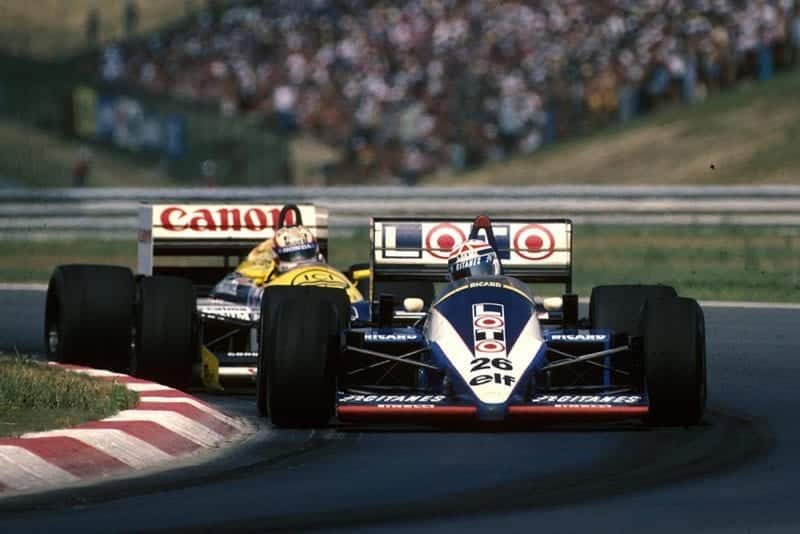
It was 12th on the grid for Ligier’s Phillipe Alliot
Motorsport Images
Amidst stories that BMW has reconsidered its decision to pull out of F1 and will agree to supply Brabham again next season “if Bernie wants us to,” the Brabham-BMW camp looked a right old shambles as is becoming usual. Both cars were fitted with massive double decker “high down force” rear wings at this circuit and the drivers both found it virtually impossible to see anything in their mirrors as a result.
Patrese was in a lot of discomfort from an infected wisdom tooth which was going to require an operation the day after the race, but he used a revised BMW M12/13 engine to qualify a respectable 14th while team-mate Derek Warwick was way down in 19th spot after a whole succession of minor tribulations.
Martin Brundle’s Tyrrell qualified 16th while Alessandro Nannini did outstandingly well in his Minardi M185B to line up 17th, three places ahead of his ostensible team leader Andrea de Cesaris who had the first of the brand new M186 chassis at his disposal. This machine is visually almost identical to its stablernates, but features a lighter, tidier, carbon fibre composite monocoque, revised suspension geometry and improved aerodynamics. It had been briefly tested at Imola in the interval following the German Grand Prix and problems with its new rear suspension had resulted in M185B components being substituted for the Hungarian race.
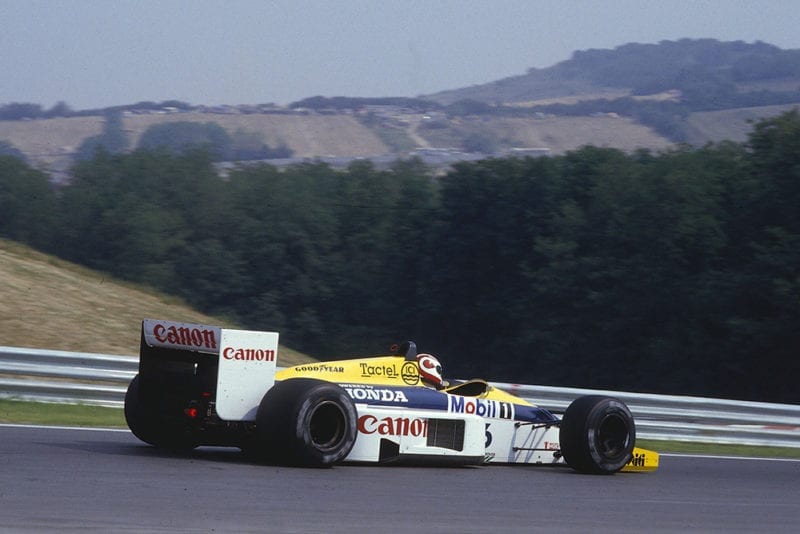
Piquet qualified 2nd behind Ayrton Senna
Motorsport Images
In the Arrows camp life seemed to be turning into a technical nightmare. After an unsuccessful debut outing tor the new A9 at Hockenheim, its new transmission, with the gear cluster positioned ahead of the differential, was put aside and the car rebuilt with a complete A8 rear end, suspension, conventional gearbox and all. Thierry Boutsen tried the A9 on Friday, but decided to revert to the old A8 for Saturday, feeling that the new machine handled poorly by comparison.
However, his problems were not over by any stretch of the imagination. On Saturday morning one car blew its engine, so he went out at the start of qualifying in the other A8 only for this car to lose turbo boost pressure. By this time a fresh engine had been installed in the first car, but it stopped on the circuit after only a few laps. Meanwhile Christian Danner had blown up the A9 and switched to the second A8 five minutes or so from the end of the session. The end result of all this mechanical carnage was that Danner and Boutsen qualified 21st and 22nd respectively, an unusually poor showing for the Milton Keynes based team. The last two rows of the grid shared by the Osella and Zakspeed teams.
Race
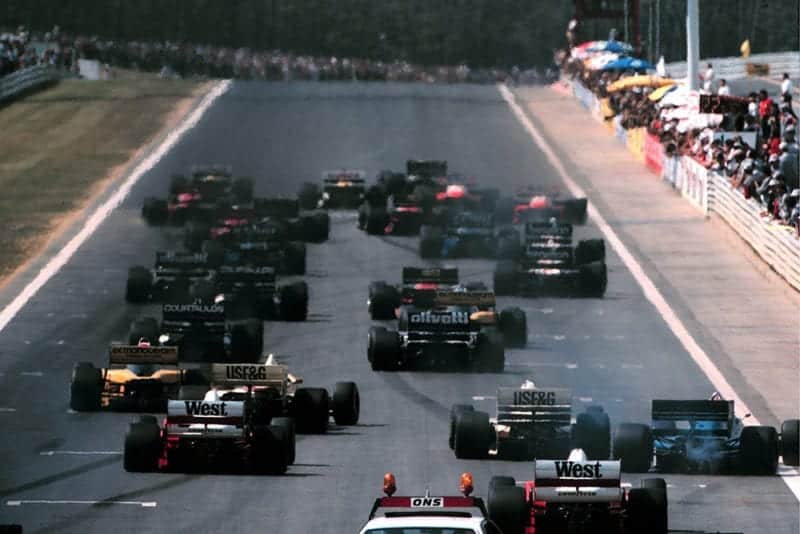
Cars scramble away at the start
Motorsport Images
The 26 cars were readied for battle in sweltering conditions on the Sunday morning, temperatures nudging over 100°F as upwards of 120,000 spectators trooped into the enclosures to witness the inaugural post-war Hungarian Grand Prix. The country’s President and several senior Government ministers arrived to take up their positions as guests of honour, formally putting their seal of approval on the proceedings and the stage was set for a great gala occasion.
Alain Prost’s troubles began on the warm-up lap when his McLaren abruptly cut out and stopped on the circuit. He jumped from the cockpit and sprinted back to the pits where he was strapped into the spare car in which he then took his place on the grid. Tyre choice was clearly going to be of crucial importance on this difficult track surface and everybody was expected to make at least one routine stop for fresh rubber.
In the Williams camp there was some tension brewing. During the three days of practice Piquet tried both his cars and concluded that a certain differential adjustment would be ideal for the race, tactically omitting to inform his team-mate (and arch-rival) of this interesting fact. The differential of Piquet’s choice was fitted to the car the night before the race. At the start it was Senna’s Lotus which sprinted into the lead with Mansell coming through from row two to take second place from Piquet on the sprint down to the first corner. Everybody negotiated the first tight complex of twists and turns without any drama and stormed off around the opening lap, the two multi-coloured Williams Hondas chasing the steel, black Lotus for all they were worth.
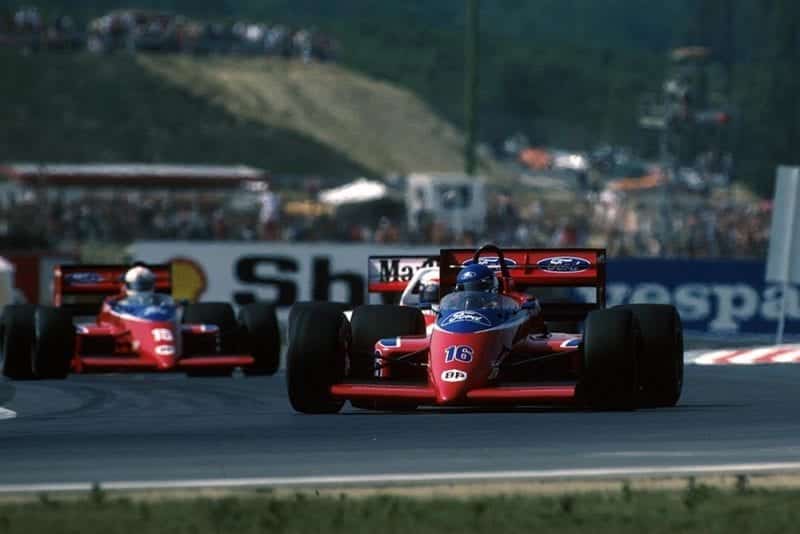
Patrick Tambay just missed out on a championship point by finishing 7th
Motorsport Images
Mansell held second place for the first couple of laps, but Piquet went by on lap three and the two Brazilians began to pull commandingly away from their pursuers. Tambay and Jones had made great starts in their Lola-Ford, holding fourth and sixth places either side of Prost’s McLaren in the opening spurt, but Prost quickly disposed of Tambay and, on lap six, displaced Mansell from third place and began steadily hauling in the leaders.
At the start of lap 10 Piquet tried to take Senna going into the first turn, but the Lotus edged over and kept him behind, but the twice World Champion was not to be denied. At the start of lap 11 he nipped by to lead and immediately began to pull away. Now Senna began to come under pressure from Prost, but just as it looked as though the McLaren would go through to second place, the Lotus came through on its own at the end of lap 16 as Prost headed for the pits.
The McLaren “grand plan” was on the verge of going very badly wrong, for Prost’s engine had developed an electrical problem and would not run properly, so the engine cover was just being unfastened when Rosberg arrived in the pits as well seeing his team-mate already stationary, the Finn drove straight through the pits back onto the circuit and came in next time round. Prost’s car was briefly pushed to one side, allowing the sixth placed Rosberg to have a quick tyre change and accelerate back into the contest yet again.
With 25 laps of the race completed it was clear that Mansell’s Williams was not in the same league as his team-mate’s. The Englishman was suffering from absolutely dire wheelspin and made the first of two tyre stops at the end of lap 28, resuming in third place but over a minute behind the leading duo. By this time routine tyre stops were going on left right and centre, the Ferrari mechanics setting a new “base time” in changing four tyres on Johansson’s F186 at the end of lap 21, the car being stationary for a mere 7.34 secs!
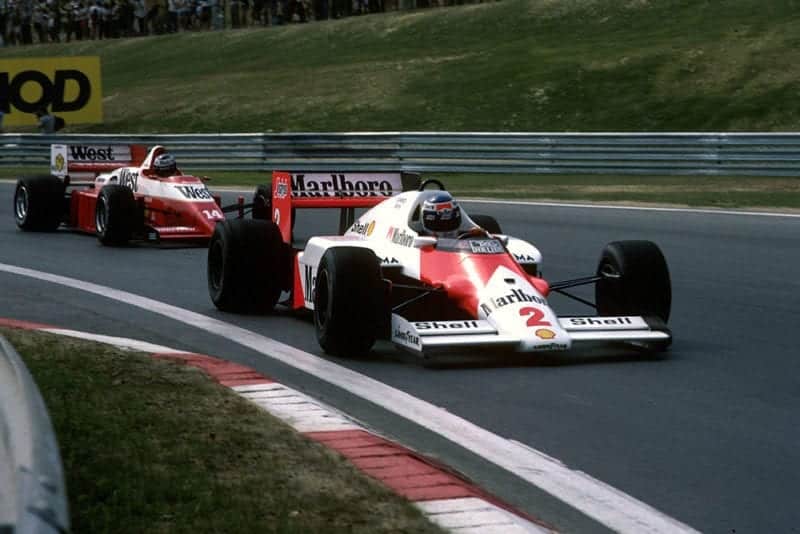
Suspension prevented McLaren’s Keke Rosberg from making the chequered flag
Motorsport Images
With the leaders on lap 24, Prost resumed the race some eight laps down, his McLaren running smoothly for another eight laps before the unusually erratic Arnoux got tangled up with him, Prost slithering to a halt with deranged suspension and the Ligier continuing after a spin. Rosberg made another pit stop, concerned about the rather sloppy handling of his car.
At the end of lap 35 he finally called it a day with broken rear suspension. At the end of lap 35 Piquet pulled in for his single tyre stop, Senna taking the lead while he was stationary. The Brazilian was nursing his tyres with his usual enviable blend of speed and sensitivity and eked them out until the end of lap 48 when, still in the lead, he tore in to have them changed. He resumed with his lead intact, his advantage over Piquet now 8.5 secs. But Nelson really got down to work from this point onwards and reduced the margin to a mere 1.1 secs by lap 53. A lap later he was right in Senna ‘s slipstream waiting to pounce!
We were now treated to some spectacular ten-tenths competition between the two Brazilians, who, despite being compatriots, are stern rivals and far from close friends. Going into lap 55, Piquet was perfectly positioned as the two cars hurtled past the pits, but as the Williams edged out to the right, starting its overtaking run down the inside towards the first right-hander, so Senna began easing over to the right as well.
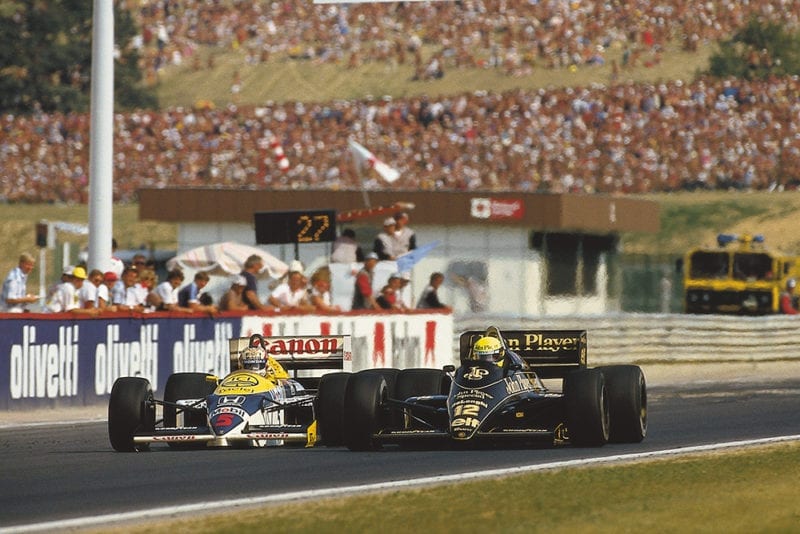
Mansell (left) and Senna vie for position
Motorsport Images
The net result was that Piquet was coming into the turn far too quickly on a far too tight a line! The Williams-Honda overtook the Lotus, but immediately slid wide onto the dust, allowing Senna to duck round the inside again and retake the lead.
Two laps later Piquet tried it on at exactly the same place, but this time he went flashing down the outside, turned across the Lotus’s nose, locked the Williams’ right rear wheel and suddenly snapped into a “dirt track slide” right in front of the leading Lotus! For a fleeting fraction of a second it seerned as though the Lotus might collect the Williams and nudge it into a spin, but as Senna bumped the black and gold machine up the inside kerb in an attempt to keep out of the way, Piquet wrestled his mount back under control, lurched back onto the inside line and emerged from the corner in the lead. It was truly breathtaking stuff between two totally committed F1 drivers and almost as exhausting to watch as it must have been for them to enact!
From that moment onwards Piquet controlled the race at his own pace, easing back at one point to let Senna catch up, only to power off into the distance again just to make the point that he was in charge. At the chequered flag he was just over 17 sec ahead, the race stopping one lap short of its originally scheduled distance as the two hour maximum cut-off point arrived.
Third, after another pit stop for tyres on lap 46 which briefly allowed him to unlap himself from Senna’s Lotus, was a frustrated Mansell, by the end lapped again by the winning Lotus and his own team-mate. Stefan Johansson made two early stops for tyres and then got his head down seriously and stormed through to finish fourth at the flag, convinced he could have been third if his team had given him a more suitable tyre combination at the second stop. Nonetheless, the Swede’s strong showing made up in some way for Alboreto’s retirement, the Italian running into the back of Warwick’s Brabham BT55, deranging the front end of his Ferrari, but limping back to the pits, while eliminating the Englishman’s machine on the spot.
Johnny Dumfries performed immaculately to finish fifth, never putting a wheel wrong all afternoon, while Martin Brundle lost fourth gear on his journey to sixth place in his Tyrrell-Renault. Patrick Tambay’s Team Haas Lola seemed set for the marque’s first Championship points, but increasing understeer slowed him after his early sprint in the top six and he eventually spun on the right-hander before the pits, needing a push-start from the marshals to get him going again. Team-mate Alan Jones was also going well in fifth place early on, but lost a lot of time in the pits with a leaking rear brake caliper and eventually stopped for good with broken transmission.
Completing the list of finishers were Philippe Alliot’s Ligier, team-mate Arnoux having suffered a major engine breakage, and Jonathan Palmer’s Zakspeed which had enjoyed a trouble-free run after losing more than two laps in the pits having overheating rear brakes bled.
The first post-war Hungarian Grand Prix might not have been the best Grand Prix race of the 1986 season, but to visit a brand new circuit and encounter such slick organisation at first acquaintance was extremely impressive. Getting contemporary F1 racing off the ground in Eastern Europe had proved to be a rip-roaring success.—A.H.
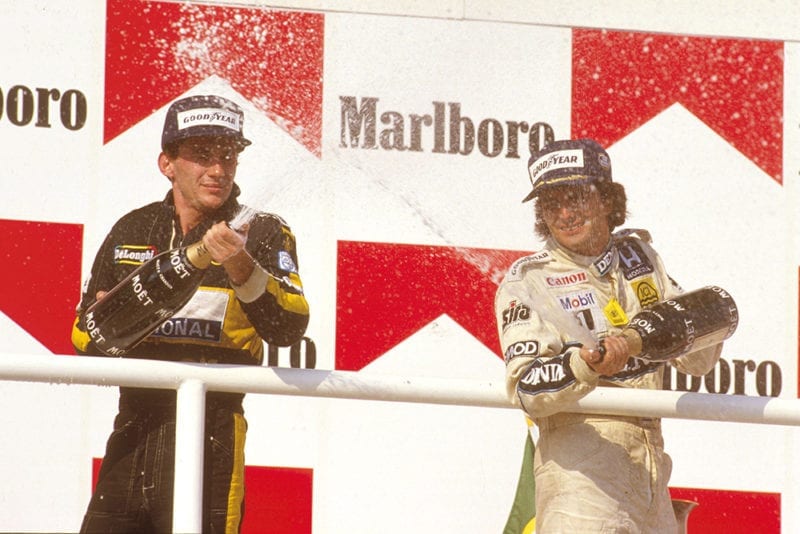
Piquet (right) celebrates with countryman Senna
Motorsport Images
Reults (top five) — Hungarian Grand Prix, Hungaroring, August 10
76 laps of 4.104 km circuit. 305.064 kilometres (189.557 miles)
1. Nelson Piquet (Williams FW11/Honda V6) — 2hr 00min 34.508sec
2. Ayrton Senna (Lotus 98T/Renault V6) — 2hr 00min 52.181sec
3. Nigel Mansell (Williams FW11/Honda V6) — 1 lap behind
4. Stephan Johansson (Ferrari F1/86-Ferrari V6) — 1 lap behind
5. Johnny Dumfries (Lotus 98T/Renault V6) — 2 laps behind
Conditions: Hot
Winner’s Avg. Speed: 158.794 km/h
Fastest lap: Nelson Piquet — 1min 31.001sec on lap 73, av. 158.794 kph — new record for new circuit.
